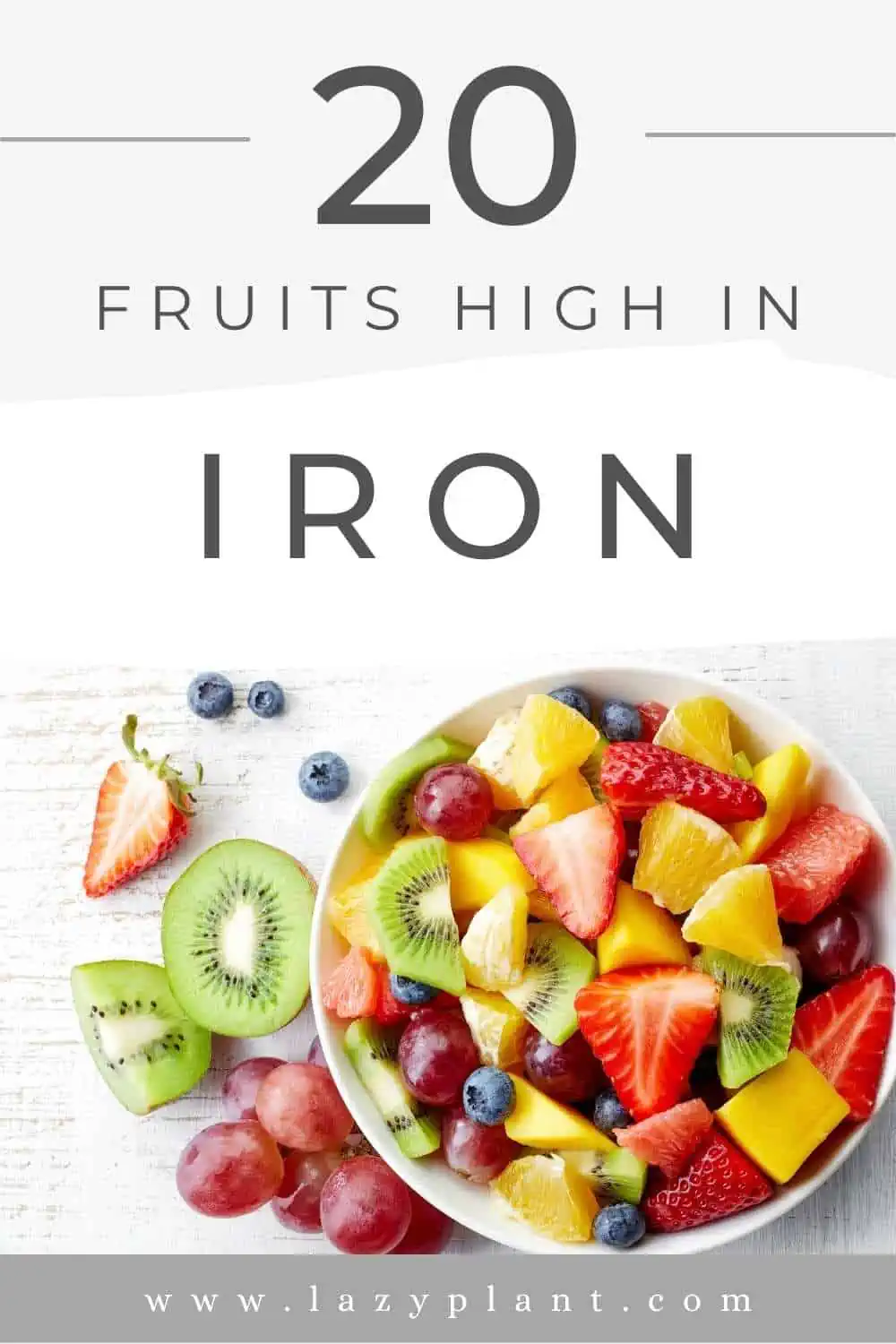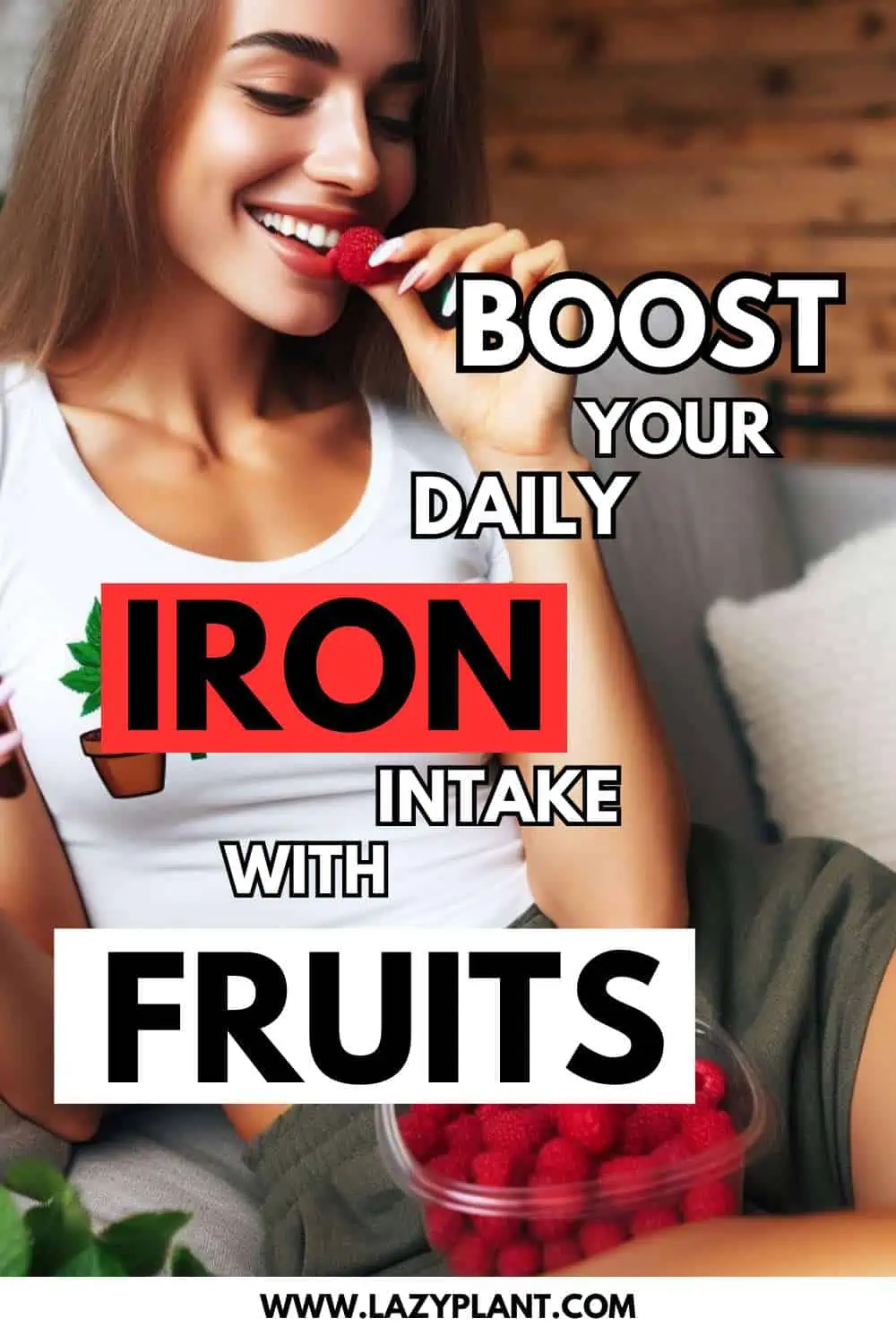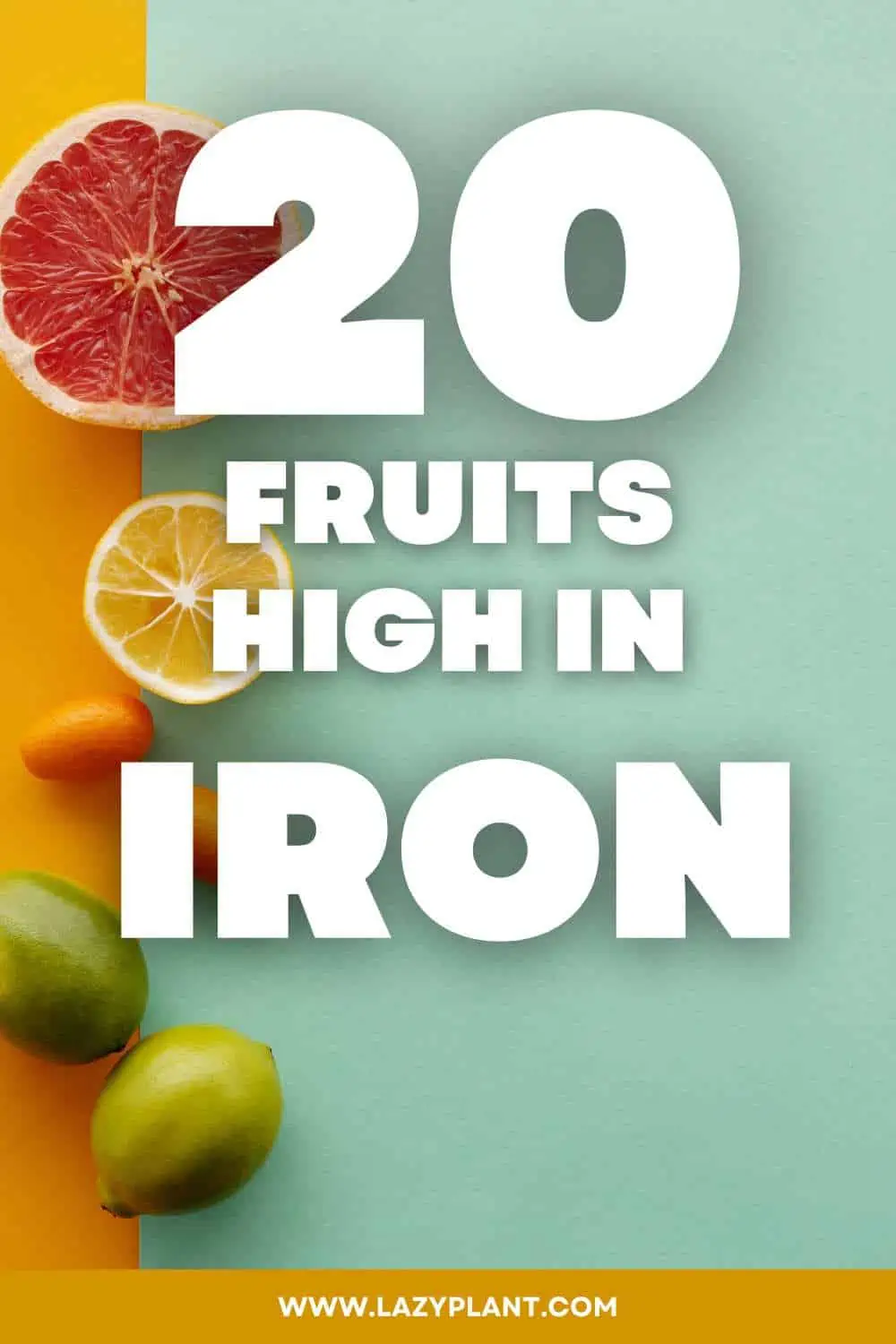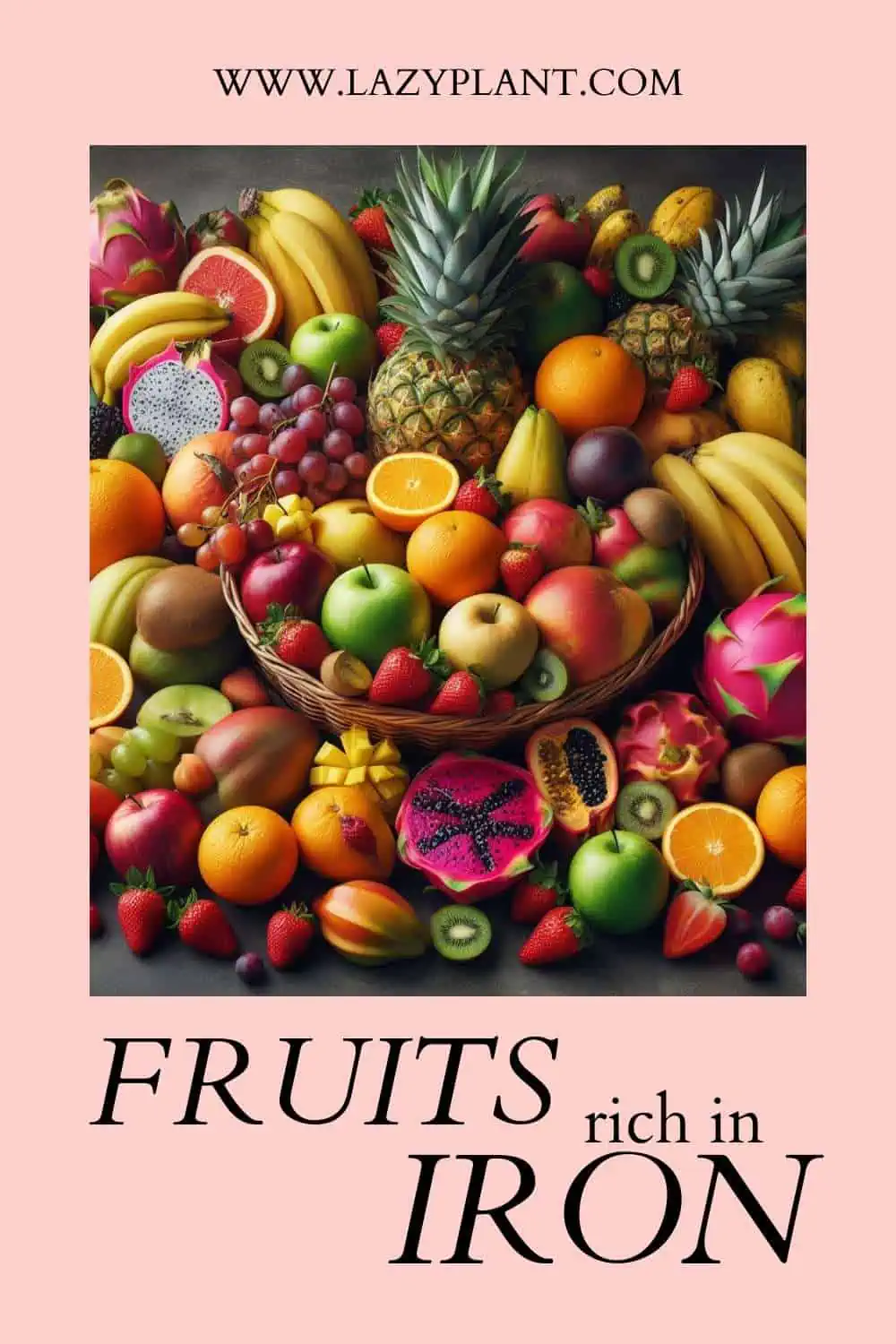Most fruits have a low iron content. Only certain fruits, such as avocado, goji berries, and raisins as well as some other dried fruits are high in iron.
How much Iron do we Need a Day?
Most people need about 8-18 mg of iron per day.[1]
Actually, our iron needs depend on age and sex:
- kids need about 7-11 mg of iron per day.
- women of reproductive age have much higher iron needs. They require about 18 mg of iron a day. Pregnant women require even more.
- men and elderly people need only 8 mg per day.
So, we have to consume many foods high in iron. We can’t get too much iron from foods. Only from dietary supplements.
Common Fruits high in Iron
The richest fruits in iron are:
| Fruit | Portion Size | Iron per Serving | % DV | Iron per 100 g |
|---|---|---|---|---|
| Goji berries | 1 oz (28 g) | 6.43 mg | 36% | 22.2 mg |
| Raisins | 1.5 oz (43 g) | 2.59 – 3.1 mg | 14-17% | 0.9 – 1.9 mg |
| Prunes | 5 dried plums (40 g) | 1.12 mg | 6% | 2.8 mg |
| Currants | 1 oz (28 g) | 1 mg | 6% | 3.4 mg |
| Raspberries | 1 cup (123 g) | 0.76 mg | 4% | 0.7 mg |
| Blackberries | 1 cup (144 g) | 0.62 mg | 3% | 0.9 mg |
| Avocado | 1 medium (136 g) | 0.61 mg | 3% | 0.4 mg |
| Lemon | 1 fruit (58 g) | 0.6 mg | 3% | 0.6 mg |
| Cherries | 1 cup (154 g) | 0.53 mg | 3% | 0.3 mg |
| Strawberries | 1 cup (152 g) | 0.41 mg | 2% | 0.3 mg |
Please note that the iron content of fruits can vary depending on the variety, ripeness, and growing conditions. The values provided are approximate and based on average values.

You could sprinkle half a handful of these iron-rich fruits on your favorite post-workout oatmeal or muesli.
Actually, prune and raspberry juices are the richest beverages in iron!
Berries are among the best natural sources!
Besides goji berries, mulberries are the richest berries in iron, providing 1.7 mg of iron per 100g. Raspberries, blackberries, and strawberries contain significantly less iron. A serving provides only 2-4% DV.
Favorite Fruits with some Iron
Other common fruits with decent amounts of iron are:
| Fruit | Portion Size | Iron per Serving | % DV | Iron per 100 g |
|---|---|---|---|---|
| Apricots | 1 cup (165 g) | 0.39 mg | 2% | 0.2 mg |
| Figs | 1 cup (149 g) | 0.37 mg | 2% | 0.2 mg |
| Grapes | 1 cup (151 g) | 0.36 mg | 2% | 0.2 mg |
| Kiwi | 1 medium (76 g) | 0.31 mg | 2% | 0.4 mg |
| Pomegranates | 1 fruit (282 g) | 0.3 mg | 2% | 0.1 mg |
| Blueberries | 1 cup (148 g) | 0.28 mg | 2% | 0.2 mg |
| Banana | 1 medium (118 g) | 0.26 mg | 1% | 0.2 mg |
| Peaches | 1 medium (150 g) | 0.25 mg | 1% | 0.2 mg |
| Watermelon | 1 cup (152 g) | 0.24 mg | 1% | 0.2 mg |
| Cranberries | 1 cup (100 g) | 0.23 mg | 1% | 0.2 mg |
Other common fruits such as apples (0.13 mg per serving), oranges (0.1 mg), grapefruits (0.09 mg), or pears (0.18 mg) have a much lower iron content.

Most Tropical Fruits are Poor Sources
Tropical fruits with some iron are:
| Fruit | Portion Size | Iron per Serving | % DV | Iron per 100 g |
|---|---|---|---|---|
| Durian | 1 cup (243 g) | 0.43 mg | 2% | 0.2 mg |
| Pineapple | 1 cup (165 g) | 0.29 mg | 2% | 0.2 mg |
| Papaya | 1 cup (145 g) | 0.25 mg | 1% | 0.2 mg |
| Mango | 1 cup (165 g) | 0.16 mg | 1% | 0.1 mg |
| Dragonfruit | 1 fruit (198 g) | 0.15 mg | 1% | 0.1 mg |
Which is the Richest Fruit in Iron?
Goji berries are the richest fruits in iron. Just a tbsp of dried goji berries contains 1.9 mg of iron or more than 10% of the recommended daily intake! They’re also particularly rich in calcium.
Dried fruits have more Iron than Fresh Fruits
Dried fruits contain much more iron than fresh fruits. Goji berries, raisins, prunes, figs, currants, and dates can help us meet our daily iron needs.
| Iron (mg), fresh fruit | Iron (mg), dried fruit | |
|---|---|---|
| goji berries | 6.43 | 6.8 |
| prunes | 1.12 | 3.5 |
| currants | 1 | 3.3 |
| cherries | 0.53 | 0.7 |
| figs | 0.37 | 2 |
| apricots | 0.39 | 6.3 |
| apples | 0.13 | 2 |
| banana | 0.26 | 1.2 |
| kiwi | 0.31 | 1.3 |
| pineapple | 0.29 | 0.8 |
| blueberries | 0.28 | 0.9 |
| papaya | 0.25 | 0.7 |
| cranberries | 0.23 | 0.4 |
Whenever possible, prefer uncooked dried fruits. They contain much more iron than cooked dried fruits. For instance, stewed figs contain only 0.88 mg per 100g. Uncooked dried figs contain 130% more iron!
Keep in mind that cooked foods may inhibit iron absorption.
How to Absorb more Iron from Fruits?
Above all, vitamin C significantly improves the absorption of non-heme iron. The type of iron which is naturally present in plants. Fruits and vegetables are the best dietary sources of vitamin C.[3]
Moreover, you should avoid drinking tea, coffee, and red wine when you consume fruits rich in iron. These beverages are pretty high in polyphenols, which inhibit iron absorption.
Polyphenols can reduce iron absorption by up to 83%.
Also, you should avoid consuming foods rich in calcium, like milk and dairy, when you eat iron-rich fruits. Calcium inhibits iron absorption.

Foods with more Iron than Fruits
Actually, plant-based common foods rich in non-heme iron are fortified cereals, beans, dark chocolate, lentils, spinach, soy products, beets, chickpeas, tomatoes, potatoes, cashew nuts, green peas, rice, whole-grain bread, pistachio nuts, and broccoli.
Heme iron is found in animal products like red meat, poultry, and fish. This type of iron is more readily absorbed by the body.
Can I Get Adequate Amounts from Diet Alone?
You can definitely get adequate amounts of iron from diet alone, but it depends on several factors like your age, sex, and overall health.
Women who menstruate, pregnant or breastfeeding women, and children have higher iron needs. People with certain health conditions may also need more iron.
While plant-based diets can be rich in iron, it’s important to be mindful because non-heme iron is less readily absorbed.
Signs of Iron Deficiency
If you’re concerned about getting enough iron, be aware of these potential signs of iron deficiency:
- Fatigue and weakness
- Pale skin
- Shortness of breath
- Cold hands and feet
- Dizziness or lightheadedness
If you experience these symptoms, it’s best to consult your doctor. They can assess your iron levels with a blood test and recommend the best course of action, which might include dietary changes or iron supplements.
For women, ferritin levels are particularly important because menstruation leads to regular iron loss. A doctor can interpret your specific ferritin level in relation to your overall health.
Do I Need Iron Supplements?
Whether you need iron supplements depends on your current iron levels, dietary intake, and any symptoms of deficiency. The best iron supplement for you will depend on your specific needs and how well you tolerate different forms of iron. Always consult with a healthcare provider to make the best choice for your health.
Best Iron Supplements
Choosing the best iron supplement depends on your specific needs and tolerances.
Here are some options:
Ferrous Sulfate: One of the most commonly prescribed iron supplements. It is effective but can cause gastrointestinal side effects like constipation and nausea.
Ferrous Gluconate: A gentler option on the stomach compared to ferrous sulfate, though it might be less potent.
Ferrous Fumarate: Another commonly used supplement that balances effectiveness and side effects.
Iron Bisglycinate: A chelated form of iron that is usually well-tolerated with fewer gastrointestinal side effects. It’s a good option for those with sensitive stomachs.
Heme Iron Supplements: Derived from animal sources, these supplements are usually more efficiently absorbed by the body. They are generally more expensive.
Liquid Iron Supplements: These can be easier on the stomach and are a good option for those with difficulty swallowing pills.
You’ll find all of them on iHerb. Subscribe to our newsletter for 5% off on all iron supplements!
Easy & Quick Recipe Ideas to boost Iron intake
Here are some recipe ideas that include fresh or dried fruits rich in iron along with other iron-packed foods to help boost your iron levels.
Iron-boosting berry smoothie: Mixed berries, chia seeds (7.7 mg/100g), spinach (2.7 mg/100g). Iron Content: Approximately 5 mg per serving.
Quinoa and apricot salad: Quinoa (2.8 mg/100g), dried apricots, almonds (3.7 mg/100g). Iron Content: Approximately 4 mg per serving.
Fig and walnut oatmeal: Oats (4.7 mg/100g), fresh figs, walnuts (2.9 mg/100g).
Dried fruit energy bites: Mixed dried fruits, nuts, seeds. Iron Content: Approximately 3.5 mg per serving.

Raspberry and Spinach Salad: Fresh raspberries, spinach (2.7 mg/100g), pumpkin seeds (8.8 mg/100g). Iron Content: Approximately 6 mg per serving. I eat a fruit salad at least 3 times a week…
Blueberry and Kale Smoothie Bowl: Blueberries, kale (1.5 mg/100g), hemp seeds (5.3 mg/100g). Iron Content: Approximately 4 mg per serving.
Cranberry and Pistachio Quinoa: Quinoa (2.8 mg/100g), dried cranberries, pistachios (3.9 mg/100g). Iron Content: Approximately 3.5 mg per serving.
Date and Almond Energy Balls: Dates, almonds (3.7 mg/100g), coconut. Iron Content: Approximately 2.5 mg per serving.
Apricot and Pumpkin Seed Trail Mix: Dried apricots, pumpkin seeds, mixed nuts. Iron Content: Approximately 4.5 mg per serving.
Blueberry and Avocado Salad: Blueberries, avocado, mixed greens. Iron Content: Approximately 2 mg per serving.
Iron content may vary based on specific brands and varieties of ingredients. Always check nutritional labels for accurate values.